NYCC Features Big Numbers and Big-Name Celebrities
In the nine years of ReedPop’s New York Comic Con, the convention has become a major event in the popular culture landscape, challenging Comic Con International’s San Diego Comic Con as the preeminent pop culture event in the U.S.
Numbers and Numbers: Apples and Oranges
This year New York Comic reached a new attendance record with reported ticket sales of 151,000. This spurred some to speculate that New York Comic Con had exceeded the scale of San Diego Comic Con, which is traditionally recognized as the largest pop culture event in the U.S.
Without independent auditing, however, it’s difficult to know what the numbers measure and whether the two totals compare apples to apples. As the noted by the San Diego Comic-Con Unofficial Blog, the New York Times stated New York Comic Con sold 151,000 “tickets,” while Comic Book Resources cited the number as indicating 151,000 “unique individuals.”
A follow-up piece the San Diego Comic-Con Unofficial Blog quotes ReedPOP Senior Global Vice President Lance Fensterman as stating “If someone bought a single day Friday and single day Sunday that would be 2 tickets sold,” implying that the New York Comic Con figure is counting tickets, not individuals. Because of its member ID system, the San Diego event can calculate the number of individuals attending, regardless of the number of tickets sold, making any comparison between the two comic conventions dubious.
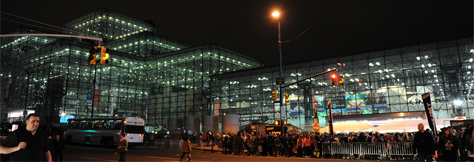
Indeed, the sizes of the two venues make it doubtful that New York Comic Con has reached the scale of the San Diego event. As the SDCC Unofficial Blog notes, the San Diego Convention Center occupies 2,600,000 square feet while New York’s Javits Center has only 1,800,000 square feet. In addition, the official activities of the San Diego event spread far beyond the Convention Center, occupying large ballrooms and other areas in the adjacent Hilton and Marriott hotels.
Even if it’s spurious to directly compare the New York number with that of San Diego, presumably ReedPOP is consistent in how it tallies New York sales each year. The growth from last year’s 130,000 tickets to this year’s 151,000 is significant, and is further evidence of the continued growth of pop culture fandom.
Beyond the Numbers
Beyond the raw attendance numbers of a comic con, however, is the quality of the programming content. Most comic conventions that cover film and television include media celebrities. There is, however, a wide range in celebrity participation, not just in the magnitude of the stars, but also in the reasons they attend: Are they at the event to hawk autographs for money or are they brought by studios to promote major media properties? While the latter has always been a hallmark of San Diego Comic Con, this year New York Comic Con featured several high-profile media events.
The Walt Disney Studios’ panel promoted both Big Hero 6 and Tomorrowland. The latter included announced guests director Brad Bird and screenwriter Damon Lindelof along with a surprise appearance by George Clooney — who visited the event straight from his honeymoon.
Michael Keaton and Edward Norton were on hand to promote Alejandro González Iñárritu’s upcoming film Birdman, about a fading superhero movie actor. Marvel’s Daredevil, the forthcoming Netflix series, announced new cast members, showed the first clips from the series, and brought lots of star power. The FX Networks series The Americans also brought several noteworthy cast members. And the powerhouse AMC TV series The Walking Dead made a return visit to NYCC with a raft of that program’s stars.
This is A-level talent and far removed from minor celebrities hawking autographs for $20 to $80 a pop. The fact that production companies now see New York Comic Con as a platform for major announcements and cast appearances may be more significant than the attendance numbers. These are the hallmarks of an influential pop culture event.
Of course, New York Comic Con still has many paid autograph events with lines of fans waiting for a signature or a photo op with a celebrity. And, as in past years, there was a smattering of vendors unrelated to the general themes of pop culture. Chevrolet returned to New York Comic Con as a partner-level sponsor with multiple presences at the show. And GEICO, fresh from their appearance at Baltimore Comic Con, occupied a large booth in the exhibition hall. While the GEICO Gecko added a touch of cosplay, any other relationship with pop culture was illusive.
Recent years have seen an increased presence of vendors looking to leverage pop culture fandom to promote unrelated products and services at a number of major comic cons, including New York Comic Con and the Wizard World cons. (See “Philadelphia Comic Con: Batman, Buffy and … Bath Fitter?” and “Consumer Brands Go Geek at Comic Con.”) San Diego Comic-Con, run by the non-profit Comic Con International, remains relatively free of such tangential marketing, at least in the space held by the con proper. (Although the rest of San Diego’s Gaslamp Quarter is awash in advertising all sorts.)
Wristbands and Room Clearing
As the major comic cons struggle to accommodate their expanding audience, they are forced to explore new methods to manage the crowds.
This past year, in an attempt to curb line-cutting, San Diego Comic-Con distributed wristbands to those waiting to enter the Convention Center’s large Hall H. New York Comic Con followed suit this year with a wristband strategy, but went one step further. Unlike San Diego’s Hall H, which allows audience members to stay in the auditorium as long as they would like, the Javits Center’s Main Stage was cleared between each panel.
In general, fans seemed pleased with this approach. The SDCC Unofficial Blog has a summary of selected opinions pro and con. (See: “New York Comic Con: New Main Stage Wristband Policy Draws Both Fans & Critics.”)
On Saturday, I targeted the Marvel’s Daredevil panel, and arrived in the wristband line roughly 15 minutes before the scheduled distribution time of 10:00 AM. The bands were given out sequentially for each of day’s lines, with the Daredevil line near the end, resulting for an hour wait to receive the band. I then arrived in the queue to enter the Main Stage about an hour before the session was scheduled to begin. I gained entry without a problem, although on entering the auditorium, the only seats available were in the rear of the room.
I thus experienced roughly a two-hour wait to see a single panel, but was unable to view any of the other sessions in on the Main Stage that day. Whether or not this is a good bargain depends largely on the breadth of your interest in the content across the day (and, of course, your willingness to tolerate long times waiting in line).
A key question is whether San Diego Comic-Con will follow suit and clear Hall H between panels. The issue is often raised in the Comic Con Talkback session that concludes each San Diego event.
Clearing the room solves the problem of people camping out in the auditorium waiting for a particular panel they want to see and, in doing so, occupying seats for earlier panels they are less interested in, taking seats away from fans who weren’t able to get in.
When the issue has been raised in the San Diego Talkback sessions, Comic Con International president John Rogers has pointed out that the disadvantage of this approach is it would reduce the number of sessions that could be held each day.
Indeed, New York Comic Con allowed an hour to clear to the auditorium in between most of the sessions on the Main Stage. By contrast, the Empire Stage, which was not cleared between sessions, scheduled sessions with only a 15-minute interval in between. On Saturday the Main Stage featured four panels and a concluding cosplay contest and Cirque du Soleil performance, while the Empire Stage offered eight hour-long panels.
Given the relative size of the two auditoria — San Diego’s Hall H is more than double the size of New York’s Main Stage — it would be difficult to imagine clearing and refilling the San Diego auditorium in less 90 minutes. This would, as Comic Con International’s Rogers predicts, nearly halve the amount of available content in the room.
Panels and People
At last year’s New York Comic Con, I skipped the panel sessions to focus on Artist Alley and the exhibition hall. This year, I was back in the panel rooms for presentations covering both entertainment and comic books.
On the entertainment side were the following sessions (click on the thumbnail images to view photo galleries of each):
Head of Television Jeph Loeb unveiled new details of Marvel’s Daredevil, the first of five series from the company to be available exclusively on Netflix. In addition to cast members Charlie Cox as the lead character, Vincent D’Onofrio as Wilson Fisk (a.k.a. Kingpin), and Deborah Ann Woll as Karen Page, the panel introduced new cast members Ayelet Zurer as Vanessa Marianna, Vondie Curtis-Hall as Ben Urich, Bob Gunton as Leland “The Owl” Owlsley, and Toby Leonard Moore as Wesley. Series showrunner Steven S. DeKnight completed the panel line up. The session also included the first clips from the show, which is placed in New York’s Hell’s Kitchen, a location only blocks from the convention center that hosted the panel.
The panel for FX Network’s The Americans featured Producers Joe Weisberg and Joel Fields along with cast members Keri Russell, Matthew Rhys, Noah Emmerich, and Annet Mahendru, moderated by Andy Greenwald. The entire team was sporting their “Commie Con” T-shirts for the event.
In the “Marvel Animation Presents” session Head of Television Jeph Loeb showed previews of Marvel’s Hulk and the Agents of S.M.A.S.H. and other Marvel Animation titles.
In the Yoshiki panel the leader of X Japan and the rest of the band answered questions from their fan base a day prior to their concert performance in Madison Square Garden.
The comic book panels included the following:
The “Marvel: House of Ideas Digital Panel” moderated by Marvel Digital Media Executive Editorial Director Ryan Penagos (a.k.a. Agent M) featured Axel Alonso, Ben Morse, Daniele Campbell, Sam Humphries, Tatiana Nahai, and C.B. Cebulski.
In the “Vertigo: Defy Conventions” panel moderator John Cunningham spoke with Shelly Bond, Rafael Albuquerque, Scott Snyder, Meghan Hetrick, Caitlin Kittredge, Marley Zarcone, Gail Simone, and Greg Lockard.
The “Image Comics: I is for Impact” panel included Chip Zdarsky, Matt Fraction, Brian K. Vaughan, Roc Upchurch, Wes Craig, Steve Orlando, and James Robinson.
The Avatar Press panel “Garth Ennis – Crossed DOA & the Future of Crossed” featured writers Justin Jordan, Kieron Gillen, Si Spurrier, and Garth Ennis, and Avatar Press Editor-in-Chief William Christensen.
My favorite comics-related panel at the con, the “Survivors of the First Comic Con” panel, was moderated by Ethan Roberts and included several participants from the first comic con held in New York in 1964: Bernie Bubnis, Rick Bierman, Art Tripp, Flo Steinberg, Howard Rogofsky, and Len Wein. I showed Steinberg, who was Marvel Editor Stan Lee’s secretary during much of the 1960s, a card I received in response to a letter I sent to Marvel’s offices roughly 50 years earlier on which she had hand-written a response on behalf of “Stan & the Gang.” She seemed pleased to hear how much the note meant to me as a young lad..
One of the highlights of New York Comic Con is the extensive Artist Alley, which ReedPOP claims is the largest of any comic con. Much of my time when not attending a panel session was spent speaking with the comic book writers and artists in Artist Alley and in publishers’ booths in the exhibition hall. Only at Comic Con will you see the president of Dark Horse Comics handing out free comic books to attendees.
Finally, of course, are the cosplayers that give the con much of its flair. While I don’t focus on costumed characters as much some photographers, it’s always exciting to see someone dressed as a favorite character (particularly an obscure one) or acting the part while in costume. This year my favorite costumes included the Steve Ditko inspired Creeper costume and a well done Beetlejuice outfit.
For the full gallery of photos from this year’s New York Comic Con, see the Flickr photo album: New York Comic Con 2014.




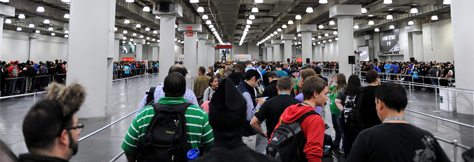
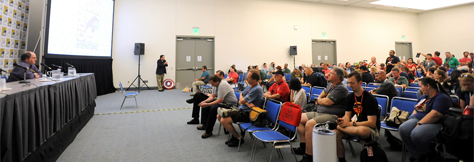
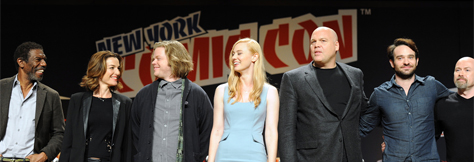

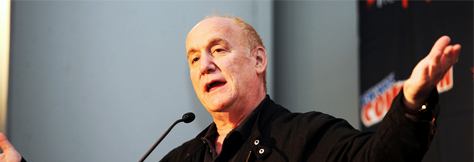




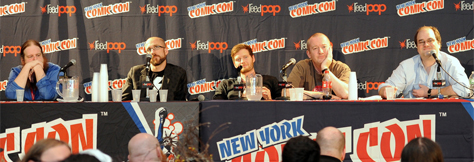

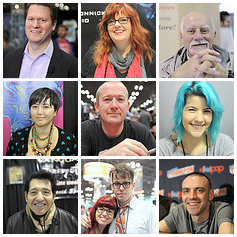
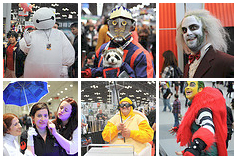





3 thoughts on “New York Comic Con 2014: Bigger and Better”